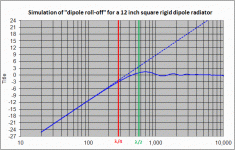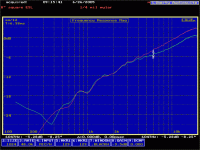Hi all,
I've recently read three explanations (see below) of 'dipole phase-cancellation' in ESL speakers, and at least two of them appear to conflict. Would anyone care to comment and help clarify my confusion on this?
Reference: Contrapunt Subwoofer Website- (http://www.euronet.nl/users/temagm/audio/dipolesub.htm):
"A specific characteristic of a dipole is the cancellation frequency... which starts when the shortest path between the positive front and the negative back wave is 0.5 wave length."
Reference: Wikapedia (on ESL's) :
"...bass rolloff 3db point occurs when the narrowest panel dimension equals a quarter wavelength of the radiated frequency..."
(my interpretation: wavelength 4X minimum panel dimension; which seems to be the inverse of Sanders' Cookbook definition below)
Ref: Roger Sanders' Cookbook, page 16:
"Phase cancellation losses begin when the wavelength of the sound is about one-quarter the minimum dimension of the speaker."
I've recently read three explanations (see below) of 'dipole phase-cancellation' in ESL speakers, and at least two of them appear to conflict. Would anyone care to comment and help clarify my confusion on this?
Reference: Contrapunt Subwoofer Website- (http://www.euronet.nl/users/temagm/audio/dipolesub.htm):
"A specific characteristic of a dipole is the cancellation frequency... which starts when the shortest path between the positive front and the negative back wave is 0.5 wave length."
Reference: Wikapedia (on ESL's) :
"...bass rolloff 3db point occurs when the narrowest panel dimension equals a quarter wavelength of the radiated frequency..."
(my interpretation: wavelength 4X minimum panel dimension; which seems to be the inverse of Sanders' Cookbook definition below)
Ref: Roger Sanders' Cookbook, page 16:
"Phase cancellation losses begin when the wavelength of the sound is about one-quarter the minimum dimension of the speaker."
After studying the frequency plots of several ESLs and open baffle dynamic speakers, it seems to me that phase cancelation is much less than any therory suggests.
Very wide esls without directivity control will tend to beam higher freqeuncies which results in a sloped response (more response with higher freq.) which me be confused with phase cancellation (lower response with lower freq)
Personally I wouldn't bother much whether it is 0,5 (more likely, as shifting 0,5 labda will make the out of phase to an in phase situation) or 0,25 labda as long as you can measure the actual response.
Very wide esls without directivity control will tend to beam higher freqeuncies which results in a sloped response (more response with higher freq.) which me be confused with phase cancellation (lower response with lower freq)
Personally I wouldn't bother much whether it is 0,5 (more likely, as shifting 0,5 labda will make the out of phase to an in phase situation) or 0,25 labda as long as you can measure the actual response.
In the 90s i Set up a pr of Acoustat panels....that two panels 9"w48"L pr side.....I put them togather side by side....no frame...took small blocks 2 1/2"x3" of wood in two spots on the back to hold the panels togather.....from the front it looket like the panels were just as close as you could get them.....on the outside of the panels i put a i put a longer pice of wood 1"x1/2" down to the floor an made a foot....so it was just the flat panels in the air..... Thay were ran fullrang.....to see if i could tell if there was any phase cancelation or cancelation of any type....all i can say if there was any it was at the vary bottem end...i well say thay sounded great an i never misset any bass....this was befor i was useing any subs...of any type...just one man finding... the panels would buzz a littel at real low frc....Thanks
The reason I'm asking for clarification between the various explanations I showed is that I want to cover the subject (dipole phase cancellation) on my DIY web page and I want to make sure I'm explaining it correctly (i.e... relationship between panel dimension and the onset of the phase cancellation).
Hello Charlie,
I would say that statements 1 & 2 are correct...dipole cancellation starts at about lambda/2 and by lambda/4 the response is -3dB down.
Statement 3 is incorrect...probably the author meant to make statement 2.
But, as MJ Dijkstra stated, with ESLs it is easy to get mixed up between dipole roll off and beaming.
Dipole cancellation rolls off the response(-6dB/oct) as the wavelength gets larger than the radiator.
Beaming boosts the response(+6dB/oct) as the wavelength gets smaller than the radiator.
So, if you took a far field measured of a square ESL(any size) you would get a response sloped @ +6dB/oct with no indication as to where dipole cancellation ended and beaming started.
Attachment #1
This plot shows the simulated response of a 12" square rigid dipole radiator.
Solid blue line ignores beaming, dashed blue line includes beaming.
NOTE: if you placed the 12" square radiator in an infinite baffle, or wall, the response would be flat up to about lambda/2 since there would be no dipole cancellation.
Above lambda/2 the response would transition to the dashed blue line as the radiator still beams.
Attachment #2
Some measurements I took several years ago of an 8" square ESL.
The Red curve is on axis...note near constant slope throught the whole response.
I took measurements of this same ESL in an infinite baffle to verify the NOTE above, but can't seem to locate it right now.
attachments...
I would say that statements 1 & 2 are correct...dipole cancellation starts at about lambda/2 and by lambda/4 the response is -3dB down.
Statement 3 is incorrect...probably the author meant to make statement 2.
But, as MJ Dijkstra stated, with ESLs it is easy to get mixed up between dipole roll off and beaming.
Dipole cancellation rolls off the response(-6dB/oct) as the wavelength gets larger than the radiator.
Beaming boosts the response(+6dB/oct) as the wavelength gets smaller than the radiator.
So, if you took a far field measured of a square ESL(any size) you would get a response sloped @ +6dB/oct with no indication as to where dipole cancellation ended and beaming started.
Attachment #1
This plot shows the simulated response of a 12" square rigid dipole radiator.
Solid blue line ignores beaming, dashed blue line includes beaming.
NOTE: if you placed the 12" square radiator in an infinite baffle, or wall, the response would be flat up to about lambda/2 since there would be no dipole cancellation.
Above lambda/2 the response would transition to the dashed blue line as the radiator still beams.
Attachment #2
Some measurements I took several years ago of an 8" square ESL.
The Red curve is on axis...note near constant slope throught the whole response.
I took measurements of this same ESL in an infinite baffle to verify the NOTE above, but can't seem to locate it right now.
attachments...
Attachments
Charlie,here is the link of the paper on dispersion that I was supposed to send you as I got side tracked,
http://www.atlassound.com/support/wPaperWideDispersion.pdf
This one is about transparency and hole sizes and related stuff,
Introduction To The Transparency Approach
and a wealth of info here,
JBL :: Technical Library
and some more great stuff on dispersion from JBL,
http://www.jblpro.com/catalog/support/getfile.aspx?docid=279&doctype=3
Enjoy !!!
jer 🙂
http://www.atlassound.com/support/wPaperWideDispersion.pdf
This one is about transparency and hole sizes and related stuff,
Introduction To The Transparency Approach
and a wealth of info here,
JBL :: Technical Library
and some more great stuff on dispersion from JBL,
http://www.jblpro.com/catalog/support/getfile.aspx?docid=279&doctype=3
Enjoy !!!
jer 🙂
- Status
- Not open for further replies.

